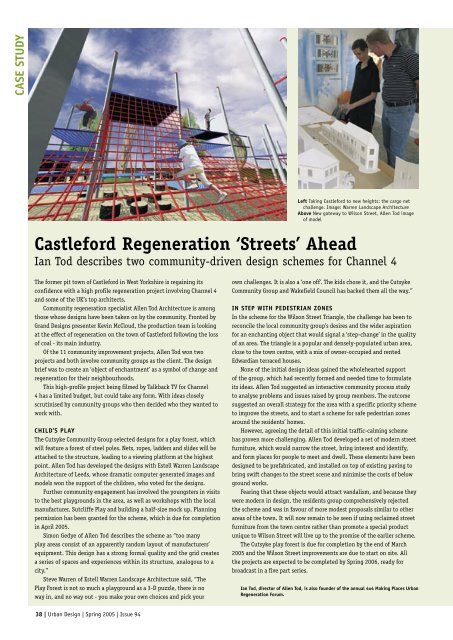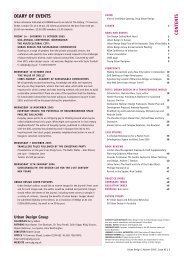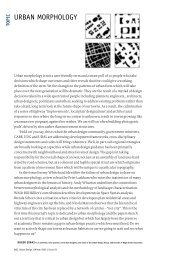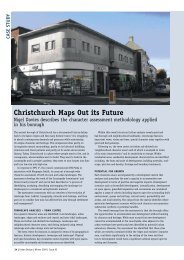CONTENTS DIARY OF EVENTS - The Urban Design Group
CONTENTS DIARY OF EVENTS - The Urban Design Group
CONTENTS DIARY OF EVENTS - The Urban Design Group
Create successful ePaper yourself
Turn your PDF publications into a flip-book with our unique Google optimized e-Paper software.
CASE STUDY<br />
Castleford Regeneration ‘Streets’ Ahead<br />
Ian Tod describes two community-driven design schemes for Channel 4<br />
<strong>The</strong> former pit town of Castleford in West Yorkshire is regaining its<br />
confidence with a high profile regeneration project involving Channel 4<br />
and some of the UK’s top architects.<br />
Community regeneration specialist Allen Tod Architecture is among<br />
those whose designs have been taken on by the community. Fronted by<br />
Grand <strong>Design</strong>s presenter Kevin McCloud, the production team is looking<br />
at the effect of regeneration on the town of Castleford following the loss<br />
of coal - its main industry.<br />
Of the 11 community improvement projects, Allen Tod won two<br />
projects and both involve community groups as the client. <strong>The</strong> design<br />
brief was to create an ‘object of enchantment’ as a symbol of change and<br />
regeneration for their neighbourhoods.<br />
This high-profile project being filmed by Talkback TV for Channel<br />
4 has a limited budget, but could take any form. With ideas closely<br />
scrutinised by community groups who then decided who they wanted to<br />
work with.<br />
CHILD’S PLAY<br />
<strong>The</strong> Cutsyke Community <strong>Group</strong> selected designs for a play forest, which<br />
will feature a forest of steel poles. Nets, ropes, ladders and slides will be<br />
attached to the structure, leading to a viewing platform at the highest<br />
point. Allen Tod has developed the designs with Estell Warren Landscape<br />
Architecture of Leeds, whose dramatic computer generated images and<br />
models won the support of the children, who voted for the designs.<br />
Further community engagement has involved the youngsters in visits<br />
to the best playgrounds in the area, as well as workshops with the local<br />
manufacturer, Sutcliffe Play and building a half-size mock up. Planning<br />
permission has been granted for the scheme, which is due for completion<br />
in April 2005.<br />
Simon Gedye of Allen Tod describes the scheme as “too many<br />
play areas consist of an apparently random layout of manufacturers’<br />
equipment. This design has a strong formal quality and the grid creates<br />
a series of spaces and experiences within its structure, analogous to a<br />
city.”<br />
Steve Warren of Estell Warren Landscape Architecture said, “<strong>The</strong><br />
Play Forest is not so much a playground as a 3-D puzzle, there is no<br />
way in, and no way out - you make your own choices and pick your<br />
38 | <strong>Urban</strong> <strong>Design</strong> | Spring 2005 | Issue 94<br />
Left Taking Castleford to new heights: the cargo net<br />
challenge. Image: Warren Landscape Architecture<br />
Above New gateway to Wilson Street, Allen Tod image<br />
of model<br />
own challenges. It is also a ‘one off’. <strong>The</strong> kids chose it, and the Cutsyke<br />
Community <strong>Group</strong> and Wakefield Council has backed them all the way.”<br />
IN STEP WITH PEDESTRIAN ZONES<br />
In the scheme for the Wilson Street Triangle, the challenge has been to<br />
reconcile the local community group’s desires and the wider aspiration<br />
for an enchanting object that would signal a ‘step-change’ in the quality<br />
of an area. <strong>The</strong> triangle is a popular and densely-populated urban area,<br />
close to the town centre, with a mix of owner-occupied and rented<br />
Edwardian terraced houses.<br />
None of the initial design ideas gained the wholehearted support<br />
of the group, which had recently formed and needed time to formulate<br />
its ideas. Allen Tod suggested an interactive community process study<br />
to analyse problems and issues raised by group members. <strong>The</strong> outcome<br />
suggested an overall strategy for the area with a specific priority scheme<br />
to improve the streets, and to start a scheme for safe pedestrian zones<br />
around the residents’ homes.<br />
However, agreeing the detail of this initial traffic-calming scheme<br />
has proven more challenging. Allen Tod developed a set of modern street<br />
furniture, which would narrow the street, bring interest and identify,<br />
and form places for people to meet and dwell. <strong>The</strong>se elements have been<br />
designed to be prefabricated, and installed on top of existing paving to<br />
bring swift changes to the street scene and minimise the costs of below<br />
ground works.<br />
Fearing that these objects would attract vandalism, and because they<br />
were modern in design, the residents group comprehensively rejected<br />
the scheme and was in favour of more modest proposals similar to other<br />
areas of the town. It will now remain to be seen if using reclaimed street<br />
furniture from the town centre rather than promote a special product<br />
unique to Wilson Street will live up to the promise of the earlier scheme.<br />
<strong>The</strong> Cutsyke play forest is due for completion by the end of March<br />
2005 and the Wilson Street improvements are due to start on site. All<br />
the projects are expected to be completed by Spring 2006, ready for<br />
broadcast in a five part series.<br />
Ian Tod, director of Allen Tod, is also founder of the annual 4x4 Making Places <strong>Urban</strong><br />
Regeneration Forum.







